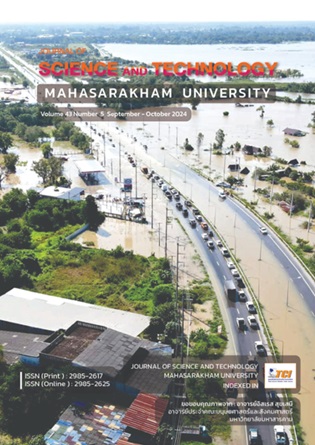Automatic in-field weather stations and smart Met4Agriculture system
Main Article Content
Abstract
The purpose of the research was to develop an automatic in-field weather station specifically for use in agricultural environments. The station was set up for use in a variety of weather conditions and research plant species. To present the data collected, a smart system named Met4Agriculture was developed. Five sensors are included in the solar-powered in-field weather station design: light intensity, temperature, relative humidity, rainfall, and soil moisture measured at a depth of 10 centimeters. Thai Meteorological Department calibrated sensors for temperature, relative humidity, rainfall, and soil moisture; Silpakorn University was responsible for the calibration of the light intensity sensor. The calibration results showed that temperature and relative humidity sensors have an accuracy deviation of approximately 1 degree Celsius and 1-3 %RH, respectively. The variance of the rainfall sensor is + 3 millimeters. The variance of the rainfall sensor is + 3 millimeters. The light intensity sensor has a deviation of 1.17 times less than the actual measured value. The soil moisture sensor's measured moisture level is trending in the same direction as the calculated soil moisture level, with a coefficient of correlation between the two values close to 1. Additionally, a program has been designed to run on the LILYGO system and develop the Met4Agriculture program. The system will connect data from the IoT NETPIE system to display the measurement data from the station. The program will reference the station's measurement points using the ID and token from the NETPIE system and further develop it into the Met4Agriculture Application, which is compatible with all platforms. It can display historical data for analysis of seasonal changes and set thresholds for each parameter that impacts agricultural crop performance during different seasons.
This research outcome enables the development of a low-cost prototype for automatic in-field weather station monitoring system for agricultural field. The prototype system shows statistically significant measurement accuracy comparable to that of standard instruments. The developed stations were installed in all five regions in Thailand, this system can continuously collect, transmit, and display real-time monitoring data through a web application and real-time mobile applications, compatible with both iOS and Android operating systems.
Article Details
References
ธิษณิน พจน์พัฒนพล, ศุภกร กตาธิการกุล, มารีนา มะหนิ. (2558) . การพัฒนาเครื่องวัดสภาพอากาศพื้นฐานแบบ อัตโนมัติ. วารสารมหาวิทยาลัยทักษิณ, ปีที่ 18 ฉบับที่ 3 , Thaksin.J., Vol.18 (3).
พันกร มนทอง. (2560). การสร้างเครื่องมือวัดพลังงานแสงอาทิตย์เพื่อเก็บข้อมูลพลังงานแสงอาทิตย์ในจังหวัดอุบลราชธานีและจังหวัดศรีสะเกษ. วิทยานิพนธ์หลักสูตรปริญญาวิทยาศาสตร์มหาบัณฑิต สาขาวิชาฟิสิกส์ คณะวิทยาศาสตร์ มหาวิทยาลัยอุบลราชธานี .
ภาสกร เดชโค้น. (2558). การพัฒนาระบบสอบเทียบเครื่องวัดรังสีอาทิตย์ตามมาตรฐานขององค์การมาตรฐานสากล. ภาควิชาฟิสิกส์ มหาวิทยาลัยศิลปากร.
สมบูรณ์ มั่นความดี ผจงจิตต์ ศรีสุข และสุภัทตรา
นุชนารถ, การพัฒนาเครื่องวัดความชื้นในดินทดแทนการนําเข้าจากต่างประเทศเพื่อจัดการดินและน้ำชลประทานในดินทรายอย่างมีประสิทธิภาพ, กรมชลประทาน, 2551
อุทัยและคณะ. (2557). เน็ตเวิร์คเซนเซอร์แบบเรียลไทม์เพื่อตรวจสอบความชื้นพืชปาล์มน้ำมันกับผลผลิต. มหาวิทยาลัยราชภัฏนครศรีธรรมราช
Rajinder Kumar M. Math, Nagaraj V. Dharwadkar. (2018). IoT Based Low-cost Weather Station and Monitoring System for Precision Agriculture in India. 2nd International Conference on I-SMAC, DOI: 10.1109/I-SMAC43168.
Nisakorn Kaewmai และ Anurak Udomvech, The Mini Weather System for Using in a Specific Small Agricultural Area, การประชุมวิชาการระดับชาติมหาวิทยาลัยทักษิณ ครั้งที่ 29 ประจำปี 2565 วิจัยและนวัตกรรมเพื่อการพัฒนาที่ยั่งยืน
WMO-No.8Seventh edition 2008. Guide to Meteorological Instruments and Methods of Observation. ISO/IEC 17025:2017 General requirements for the competence of testing and calibration laboratories. (https://www.iasonline.org/wp-content/uploads/2021/02/ISO-IEC-17025-2017-IAS.pdf). Rain Gauge Calibrator (https://novalynx.com/manuals/260-2595-manual.pdf)


